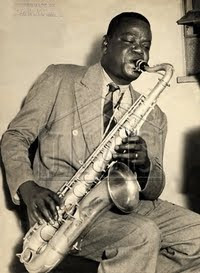Saxophone, Why Cry?
 The classic choro tune, "Saxofone, Por Que Choras", is still performed by choro ensembles of today - it has become a part of the standard book repertoire. The piece was composed and recorded in 1930 by the highly accomplished pioneer of the saxophone in Brazil, Severino Rangel de Carvalho (1896-1972), better known through his artist name as Ratinho. Ratinho was not the first to play choros on the saxophone, but he was the main discoverer of this instrument in Brazilian popular music through his compositions and accomplished performance.
The classic choro tune, "Saxofone, Por Que Choras", is still performed by choro ensembles of today - it has become a part of the standard book repertoire. The piece was composed and recorded in 1930 by the highly accomplished pioneer of the saxophone in Brazil, Severino Rangel de Carvalho (1896-1972), better known through his artist name as Ratinho. Ratinho was not the first to play choros on the saxophone, but he was the main discoverer of this instrument in Brazilian popular music through his compositions and accomplished performance.
Ratinho was from the North East part of Brazil, Pernambuco state. In 1918 he met José Luís Rodrigues Calazans (1896-1977), known as Jararaca. Together with guitarists Pirara and Romualdo Miranda, the cavaquinho player Robson and the percussionist Artur Souza they formed Bloco dos Boêmios. In that group all members adopted nicknames designating animals, and Jararaca and Ratinho kept theirs throughout their careers. In July 1921 Bloco dos Boêmios had a job at a theatre in Recife together with the visiting Oito Batutas, the famous Pixinguinha group. Inspired by Pixinguinha, Donga and the other Batutas the group adopted the name of Turunas Pernambucanos (see picture above) and were invited to perform in Rio 1922. With their typical northeastern clothing and music they were an instant success in Rio, soon receiving the invitation to record for Odeon. At the same time the group did a six-month tour of the South of Brazil and extended the tour to Buenos Aires, Argentina, but dissolved soon afterwards. Jararaca & Ratinho remained for some time in Montevideo, Uruguay, performing together as a duo, but then moved on to São Paulo in 1927.

Their first big opportunity came in 1928, when crooner Francisco Alves recorded "Meu Sabiá" (by Jararaca) for Odeon. In 1929 the duo recorded their first album for Odeon including "Caipirada" and "Lista do Baile" (both by Jararaca & Ratinho). As humorists they interspersed sketches with musical acts. In the next year Ratinho recorded some of his waltzes and choros, including the choro "Saxofone, Por Que Choras". Becoming a permanent attraction with the public the duo also had room for the solo careers of their members. Jararaca's carnavalesca march "Mamãe Eu Quero" (a co-work with Vicente Paiva), recorded by Jararaca for Odeon, was a big hit in the carnival of 1937, remaining a classic marchinha performed in every carnival to this day.
.jpg) The duo was hired by the Rádio Nacional on a permanent basis from 1936 to 1945. They had a show of their own and also performed in other shows, where Ratinho played his choros on the saxophone. At the same time they continued recording albums for Odeon and touring the country. They also worked for TV. In 1998 a compilation of their works was published by Funarte/Atração on the CD Jararaca e Ratinho (ATR 32057), still available.
The duo was hired by the Rádio Nacional on a permanent basis from 1936 to 1945. They had a show of their own and also performed in other shows, where Ratinho played his choros on the saxophone. At the same time they continued recording albums for Odeon and touring the country. They also worked for TV. In 1998 a compilation of their works was published by Funarte/Atração on the CD Jararaca e Ratinho (ATR 32057), still available.
Above info excerpted from article by Alvaro Neder in AMG
I found a performance of Ratinho's "Saxofone, Por Que Choras" inserted below in the memory of Jararaca & Ratinho
Jo



1 Comments:
Here is a link to sheet music of "Saxofone Por Que Choras" for tenor sax:
http://saxofonebr.tripod.com/fotos/porquechoras2.jpg
Jo
Post a Comment
<< Home